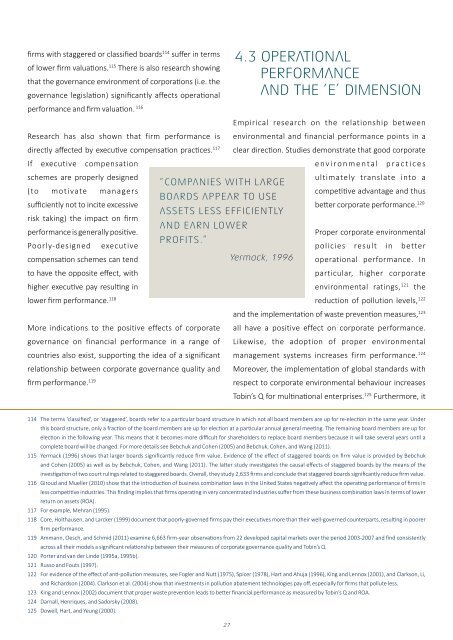oxford-study-pdf
oxford-study-pdf
oxford-study-pdf
- No tags were found...
You also want an ePaper? Increase the reach of your titles
YUMPU automatically turns print PDFs into web optimized ePapers that Google loves.
firms with staggered or classified boards 114 suffer in termsof lower firm valuations. 115 There is also research showingthat the governance environment of corporations (i.e. thegovernance legislation) significantly affects operational4.3 OperationalPerformanceand the ‘E’ Dimensionperformance and firm valuation. 116Empirical research on the relationship betweenResearch has also shown that firm performance isdirectly affected by executive compensation practices. 117environmental and financial performance points in aclear direction. Studies demonstrate that good corporateIf executive compensationenvironmental practicesschemes are properly designed“Companies with largeultimately translate into a(to motivate managerscompetitive advantage and thusboards appear to usesufficiently not to incite excessivebetter corporate performance.assets less efficiently120risk taking) the impact on firmand earn lowerperformance is generally positive.Proper corporate environmentalprofits.”Poorly-designed executivepolicies result in bettercompensation schemes can tendto have the opposite effect, withhigher executive pay resulting inYermack, 1996 operational performance. Inparticular, higher corporateenvironmental ratings, 121 thelower firm performance. 118reduction of pollution levels, 122and the implementation of waste prevention measures, 123More indications to the positive effects of corporategovernance on financial performance in a range ofcountries also exist, supporting the idea of a significantrelationship between corporate governance quality andfirm performance. 119all have a positive effect on corporate performance.Likewise, the adoption of proper environmentalmanagement systems increases firm performance. 124Moreover, the implementation of global standards withrespect to corporate environmental behaviour increasesTobin’s Q for multinational enterprises. 125 Furthermore, it114 The terms ‘classified’, or ‘staggered’, boards refer to a particular board structure in which not all board members are up for re-election in the same year. Underthis board structure, only a fraction of the board members are up for election at a particular annual general meeting. The remaining board members are up forelection in the following year. This means that it becomes more difficult for shareholders to replace board members because it will take several years until acomplete board will be changed. For more details see Bebchuk and Cohen (2005) and Bebchuk, Cohen, and Wang (2011).115 Yermack (1996) shows that larger boards significantly reduce firm value. Evidence of the effect of staggered boards on firm value is provided by Bebchukand Cohen (2005) as well as by Bebchuk, Cohen, and Wang (2011). The latter <strong>study</strong> investigates the causal effects of staggered boards by the means of theinvestigation of two court rulings related to staggered boards. Overall, they <strong>study</strong> 2,633 firms and conclude that staggered boards significantly reduce firm value.116 Giroud and Mueller (2010) show that the introduction of business combination laws in the United States negatively affect the operating performance of firms inless competitive industries. This finding implies that firms operating in very concentrated industries suffer from these business combination laws in terms of lowerreturn on assets (ROA).117 For example, Mehran (1995).118 Core, Holthausen, and Larcker (1999) document that poorly-governed firms pay their executives more than their well-governed counterparts, resulting in poorerfirm performance.119 Ammann, Oesch, and Schmid (2011) examine 6,663 firm-year observations from 22 developed capital markets over the period 2003-2007 and find consistentlyacross all their models a significant relationship between their measures of corporate governance quality and Tobin’s Q.120 Porter and van der Linde (1995a, 1995b).121 Russo and Fouts (1997).122 For evidence of the effect of anti-pollution measures, see Fogler and Nutt (1975), Spicer (1978), Hart and Ahuja (1996), King and Lennox (2001), and Clarkson, Li,and Richardson (2004). Clarkson et al. (2004) show that investments in pollution abatement technologies pay off, especially for firms that pollute less.123 King and Lennox (2002) document that proper waste prevention leads to better financial performance as measured by Tobin’s Q and ROA.124 Darnall, Henriques, and Sadorsky (2008).125 Dowell, Hart, and Yeung (2000).27


